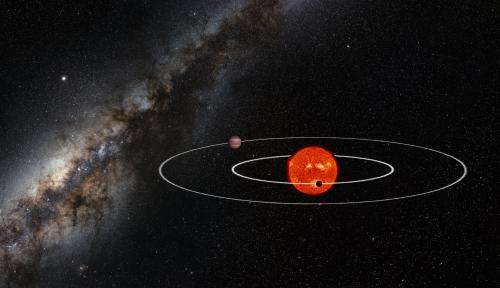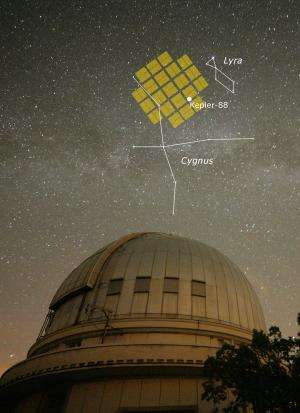First detection of a predicted unseen exoplanet

A team of European astronomers, including EXOEarths member Alexandre Santerne (CAUP), used the SOPHIE spectrograph at the Observatoire de Haute-Provence (France), to confirm the presence of Kepler-88 c, an unseen planet that was previously predicted thanks to the gravitational perturbation it caused on its transiting brother planet, Kepler-88 b.
Searching for periodic transits in hundreds of thousands of stars was the primary goal of the Kepler space telescope. More than 3,500 of such periodic transits were found during the 4 years of the mission. However, not all the planets located in the Kepler field-of-view are transiting their host star. Indeed, if their orbital plane is slightly misaligned (only a few degrees is enough) with the line of sight from the Earth, the planet is not transiting and, thus, is "unseen" from the Kepler spacecraft.
Planets that share the same host star gravitationally interact with each other. This interaction between planets can cause perturbations in the predicted times of transit of planets in multi-planetary systems. "This is called transit timing variations (TTV)" explains the leading author of the paper, Susana Barros, a researcher at the Laboratoire d'Astrophysique de Marseille (LAM).
The TTV technique is sensitive to planets in multiple systems down to the mass of the Earth, and can therefore be used to unveil the existence of non-transiting planets, that cause perturbations in the orbital motion of transiting planets.
This is the case of the Kepler-88 system, which hosts a transiting planet (Kepler-88 b), discovered by the Kepler space telescope (NASA) , that is strongly perturbed by a non-transiting planet (Kepler-88 c). "This system presents such strong interactions that it has earned the nickname of the king of transit variations" adds Rodrigo Diaz, a researcher working at the Geneva Observatory (OAUG).

A careful analysis of the dynamical interaction between planets, previously performed by a team led by David Nesvorny (Southwest Research Institute), predicted that this system had two planets near a two-to-one resonance (the orbital period of the unseen outer planet is exactly two times longer than the transiting inner planet). This configuration is similar to the Earth and Mars in the solar system, with Mars orbiting the Sun in nearly 2 years.
Using the SOPHIE velocimeter, the team independently measured the mass of Kepler-88 c. "SOPHIE is a French instrument capable of measuring the velocity of stars with a precision equivalent to the speed of a bicycle. It has been used to characterize nearly 20 Kepler planets so far" adds Alexandre Santerne a researcher at Centro de Astrofísica da Universidade do Porto (CAUP) and responsible of the observations of Kepler targets with SOPHIE.
The inferred mass for the unseen planet is in perfect agreement with the value that was predicted from TTV. "This is the first time that the mass of an unseen exoplanet inferred based on transit timing variation is independently confirmed by another technique," comments Susana Barros. This result therefore confirms TTV as a valid technique to detect unseen planets and explore multiplanet systems. TTV has already been used to determine the mass of more than 120 exoplanets detected by Kepler, around 47 planetary systems, down to a few Earth-mass planets.
"This independent confirmation is a very important contribution to the statistical analyzes of the Kepler multiple planet systems. It helps to better understand the dynamical interactions and the formation of planetary systems. This also permits to anticipate the future exploration of exoplanetary systems from space as would do the PLATO mission" concludes Magali Deleuil, professor at Aix-Marseille University and leader of LAM's exoplanet research.
Neptune was the first planet detected based on the gravitational influence it had on another planet (Uranus). The French mathematician Urbain Le Verrier calculated that the anomalies in Uranus orbit were due to a two-to-one resonance from a previously unseen planet. His calculation led Johann Gottfried Galle to find Neptune on September 23, 1846.
The article "SOPHIE Velocimetry of Kepler Transit Candidates X KOI-142c: First Radial Velocity Confirmation of a Non-Transiting Exoplanet Discovered by Transit Timing," is published 17 December 2013 in Astronomy & Astrophysics: dx.doi.org/10.1051/0004-6361/201323067
Journal information: Astronomy & Astrophysics
Provided by Centro de Astrofisica da Universidade do Porto



















